| Previous Unloads: | |
|
1991 May: A Visit to Langkawi, the Land of Mahsuri 1991 Aug: Study tour to Medan, Indonesia 1994 May: First Asia Pacific Chitin and Chitosan Symposium (APCCS) 1995 Dec: Revisiting SAS 1997 Dec: Rally Nationwide Vision 1998 Apr MOU and Launching of Chito-Chem (M) Sdn Bhd 1999 Sep: The Officiation of Smart Technology Centre, UKM 1999 Sep 23: A Week on Leave 1999 Dec: Study Tour to Taiwan 2000 Jul: A MiniReunion of Class of 66 2000 Dec: Just An Unlucky Day |
2001 Jul: 29th Covocation of UKM 2001 Dec: Digging Deep Into the Root: SKBT Revisited 2002 Sep: A Consequential Events from Feb 2002 2003 Apr: Reminiscing the Little Boy 2003 Nov: Reunion of Class of 66 2004 May: Cameron Highland Revisited 2004 Jul: In the Heart of Two Cities 2005 Jan: SAS Re-revisited 2005 Jan: Seri Puteri Eventually Visited 2005 Apr: In the Backyard (and Frontyard) 2005 Nov: Jalan Hale Revisited |
| Jalan Hale, Kg Baru, Revisited (Dated: 2005 Nov) |
| There is a place in Kuala Lumpur, called Kampong Baru. In 1940's to 1950's it was the heart of Kuala Lumpur and it was the Kuala Lumpur since 1800's. When tin miners began to congregate, the hecticity of Kuala Lumpur moved to areas with today's landmarks such as Petaling Street, Batu Road (Jln Tuanku Abdul Rahman) and Chow Kit Rd. There was a street running in the middle of Kg Baru: Jalan Hale, which was renamed as Jalan Raja Abdullah in the late 1970's. It spans fron Jalan Campbell to Jalan Raja Muda. Many avtivities in Kg Baru however occured along the streets off Jalan Hale. In 1970's a premise was of interest: it was the girls hostel of Sekolah Alam Shah. My last intentional visit to this place was in 1971 Nov 28 Sun. After 35 years had passed, in 2005 Nov 22 Tue, I passed by the road again intentionally. Naturally, it has changed, although the gradient is not as steep as at other places in Kuala Lumpur. But one thing changed very little: the SAS girls hostel changed to Sekolah Kebangsaan Pendidikan Khas. |
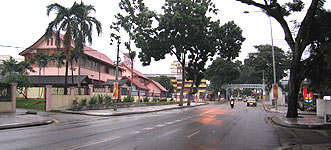 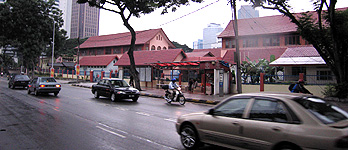 Jalan Hale, (left picture) shortly after turning left from Jalan Sultan Ismail. The part of Jalan Hale from Jalan Campbell is rather complicated to approach due to the metropolitanisation of Jalan Sultan Ismail which at this particular part was extended from the portion in the golden triangle to cross Jalan Tuanku Abdul Rahman and then Jalan Raja Laut. In the 1970's it was via Jalan Campbell in order to go to Jalan Hale. The serenity of the original Kg Baru could still be felt, in a b/w contrast to the metropolitanness of Jalan Sultan Ismail. (Right picture) the opposite approach from Jalan Raja Muda. The road has been widened with the concommitant narrowing of the pavement; less big trees to make ways to the new buildings and replacement buildings. |
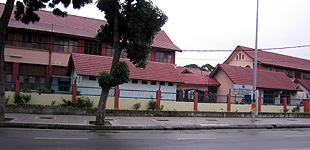 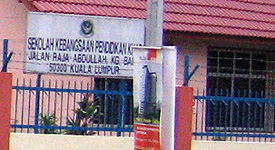 The premise was changed to Sekolah Kebangsaan Pendidikan Khas. More buildings were erected in the area towards Jalan Raja Muda; it was actually a complex just like an ordinary school complex. |
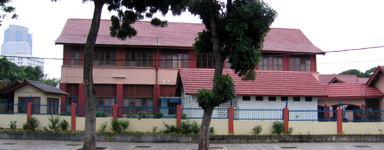 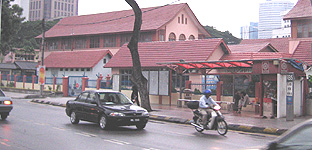 The original double-storey main building where the girls dorms were (minus the store-like building infront of it); the gate; and the bus stand at which we used to drop off Sri Jaya bus from Sultan Mohamad bus station - the materials are naturally renewed, but the souls were the same, and the same spirits are hovering to keep the events carved up. For three years, 1967 to 1969, this place was a 'foreign land' to me even though it was the SAS girls hostel, because I had no business or reason to be there, not even to the famous 'Pasar Minggu' nearby. But in 1970, I had to go there many times. I had duty to performed, and I had an 'object of attraction' that pushed me to be there. These two reasons worked in tendem, diffuse with each other, facilitate one another, and carved a permanent story picture within the short time, like any school activities such as sports day, speech day, or talent time: Jalan Hale, Kg Baru and Pasar Minggu were a lyric of a boy's life rhythm; like flood water in Terengganu. I wished very much to get inside the building again; to see the lounge in which the girls were watching weekly cenematic film, with the sattees sitting on which the stair to upstair is visible, the table with a TV on it; the walkway to the warden's place and to the kitchen. But I do not have a reason today, unlike in the 1970. The most memorable frolics I had in the building was during the Eid Haji 1970 Feb 16-17 Mon Tue (school holidays) when I spent quite a few hours at the site. And two very short ones at the place in 1971 Nov 28 Sun in concluding my acquaintancing my juniors in SAS. Since then I had no reason whatsoever to be there. |
 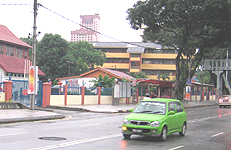 Jalan Hale now changed to Jalan Raja Abdullah, and it is as busy as any other streets in Kuala Lumpur. Over bridges were built for the padestrian to cross the road. The 'arrival' bus stand on the left side of the road; and the 'departure' bus stand on the right side of the road. The added class rooms in 4-storey block of the new school is visible in the background; the hostel thus is deliberately preserved, possibly for the staff uses, or any activities out-bound to the pupil. |
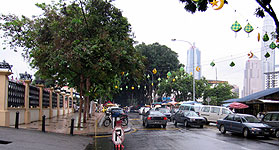 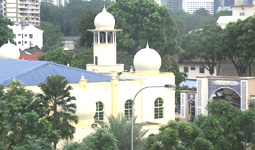 The mosque, two streets off, at Jalan Raja Uda. I prayed in this mosque perhaps only once throughout. It was 1970 Jul 24 Fri prayer with Tajul. It was a day away from the second term break, the school had officially ceased for the term; Tajul asked me to accompany him, and I needed someone to accompany too to the same place. It was a memory-carving frolics as well; We stopped first at the hostel and then together we went for a stroll along Jalan Chow Kit. When the noon came we got excused for the prayer; then returned to resume with a makan-makan at the Pasar Minggu. The day ended very fast. Then Tajul and I left for the hostel in Cheras. I returned for picking up the next very early morning. Then two weeks break; everyone went to their family at home. |
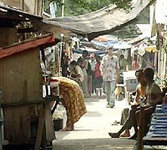 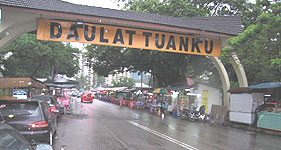 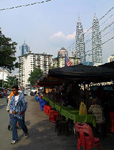 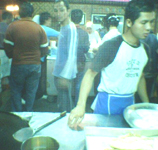 The most famous spot of the time in Jalan Hale: the Pasar Minggu, Jalan Raja Muda Musa. The way it was which has disappeared, and the entrance street today. The remaining are just mobile hawkers alongside the the street. But the spirit remains and became a tourist spot contageously all over the streets nearby. As always, the ever-lasting business is the food business which is exactly what the Pasar Minggu is now about talk of the town: the nasi lemak. Since the beginning, the 'big event' at this market place started from Sat evening and finished at wee hours of Sun morning; but these days, people need money every minute, not just on Sat evening, so it opens every day and night. My last visit to this pasar minggu in 1970 was Aug 8 Sat evening with fellow closest buddies in SAS, Sulaiman, Husin, and Izzuddin. It was at the very beginning of final term 1970. Not all students have returned to the hostel yet. |
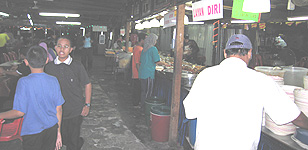 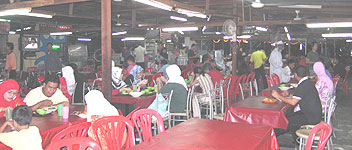 An evening in Pasar Minggu, Kampong Baru, 2005 Dec 17 Sat. It's very unpleasant to come during the time because the traffic is so tight. |
 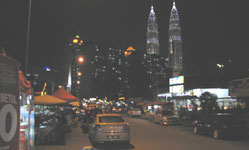 The street of the Pasar Minggu; the ubiquitous background. This is Kuala Lumpur, in the state of a very original. |
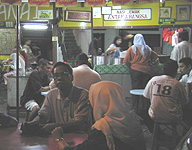 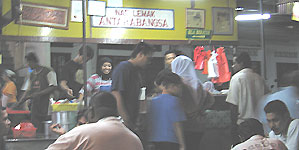 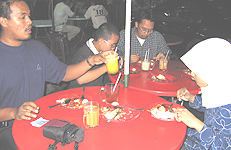 The nasi lemak antarabangsa. Many more stalls sell nasi lemak, all were exotic looking. A deeper look into the contemporary Pasar Minggu revealed an unmistakble newness: a second wave of archipalego emigration is in the making; deutro-indon are osmosizing to fill up every inch of space. |
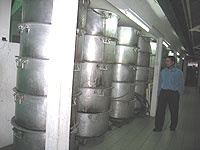 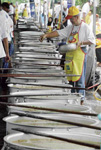  In ramadan, out of the mosque came the famous 'bubur lambuk'. The stacks of 'periuk' and those sheer big periuks when in use in their number. |
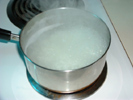  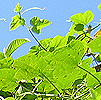  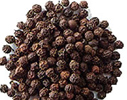 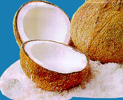 To this date I have tasted only once (the first and last) the 'famous' bubur lambuk. Since then I put it in single quote because it does not taste like the one my mother used to do it which we enjoyed to the last scoop of it, in ramadan or not. The recipe is very simple and does not use condiments as much as those in the 'famous' one. First the rice is boiled to a congee soft. Then the veg which is the red fern ('pucuk midin') plus some of the shoot of ulat bulu (wild melon), followed by ground grilled fish (preferably the 'selayang' - sardine - species) and ground black pepper. Lastly just before serving, coconut milk and salt are added. Notes: 1 The only condiment used is the black pepper. It is added for the hot taste, so adjust to taste. White pepper is not 'tasty' enough. 2 The fish added is to 'sweet' the taste. Selayang is the best fish, followed by selar and kembong respectively. Never cencaru because it is tasteless. The best grilling method is using the wood carcoal from raw wood. In desperate case the fish can be boiled with a minimum amount of water (or steamed - 'kukus'). 3 The more coconut milk added, the more 'lemak' taste. The green fern are out of question. |
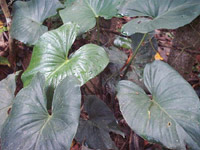 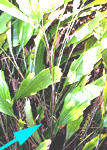 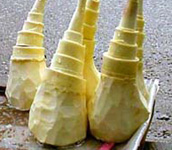 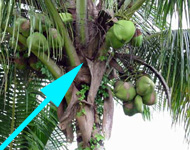 For more exotic taste, the following flora shoot are added the proportion of which are minor, but will impart a great taste (like that of MSG action): (in increasing order of difficulty to get) 1 The shoot of 'kemoyang', a kind of small yam grown wildly around a home. 2 The 'umbuk ngedin', a small palm type flora, also grown wildly around (its biggest sister is the giant 'kabung' the sap of which, like of coconut, are made into sugar). 3 Bamboo shoot freshly cut and worked out from the orchard (BEWARE! NEVER USE the preserved type that is sold in the wet market that smell like a squatters backyard; the canned bamboo shoot is very much less tasty). 4 The 'umbuk nyior' - the fleshy part at the top of a coconut tree; to get this a coconut tree has to be felled down, work out very hard to reach to soft core of it. When I was a boy, my mother could rely on me for the ingredient 1 and 2. I sometimes helped her for the ingredient 3. Ingredient 4 was very rare; it had to wait for an occasion whence a coconut tree had to be felled down - alas, we need only a 'pinch' of it. Normally it worked backward: we would make the exotic 'bubur lambuk' whenever there was a coconut tree felled down. |